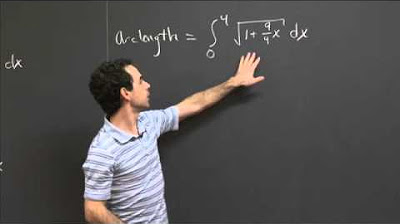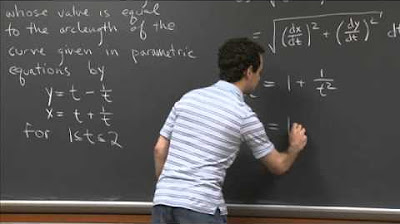Finding Arc Length Using an Integral
TLDRThis video tutorial guides viewers through calculating the arc length of a function over a specific interval, a common task in calculus. The presenter explains the formula for arc length, involving the derivative of the function and a square root expression. The example given uses the function y = x^(2/3) from x = 1 to x = 8, demonstrating the process of finding the derivative, setting up the integral, and simplifying the expression. The video illustrates the use of u-substitution to evaluate the integral and find the exact arc length, emphasizing that while such problems often require a calculator, the example shown can be evaluated exactly, providing a clear method for students to follow.
Takeaways
- 📚 The video is about calculating the arc length of a function on a specific interval.
- 🔍 The formula for arc length from x=a to x=b is √(1 + (dy/dx)^2), where dy/dx is the derivative of y with respect to x.
- 📝 Derivatives are essential for finding the arc length, and the example given is y = x^(2/3).
- 📈 The process involves setting up an integral with the square root of 1 plus the derivative squared in the numerator.
- 🧩 The integral often requires simplification and might end up being a calculator problem or set up without evaluation.
- 🔑 The example provided is s = ∫ from 1 to 8 of √(1 + (2/3 * x^(-1/3))^2) dx.
- 📉 The derivative of y = x^(2/3) is found using the power rule, resulting in 2/3 * x^(-1/3).
- 📝 After simplifying, the integral becomes ∫(1/8 * √(1 + 4/(9x^(2/3))) dx).
- 🔄 Factoring and finding a common denominator helps in simplifying the integral for u-substitution.
- 🔄 U-substitution is used with u = 9x^(2/3) + 4, and du is found accordingly.
- 📊 The bounds of integration are converted from x values to u values, which are 13 and 40 respectively.
- 📐 The final integral to solve is ∫(1/6 * u^(1/2) du) from 13 to 40, which can be evaluated.
- 📝 The final result is given as 1/27 * (40^(3/2) - 13^(3/2)), without further simplification.
Q & A
What is the main topic of the video?
-The main topic of the video is calculating the arc length of a function on a specific interval.
What formula is used to calculate the arc length from x=a to x=b?
-The formula used to calculate the arc length is the square root of (1 + (dy/dx)^2).
What is the derivative of y = x^(2/3)?
-The derivative of y = x^(2/3) is (2/3)x^(-1/3) using the power rule.
Why might some arc length problems be difficult to evaluate?
-Some arc length problems are difficult to evaluate because the integral of the square root of 1 plus something squared might not be easily solvable.
What is the integral set up for the example given in the video?
-The integral set up for the example is the integral from 1 to 8 of the square root of (1 + (4/9)x^(-2/3)) dx.
How does the video simplify the expression under the square root in the integral?
-The video simplifies the expression by factoring and finding a common denominator, which leads to recognizing a perfect square under the square root.
What substitution is used in the video to simplify the integral?
-The video uses a u-substitution where u = 9x^(2/3) + 4, and du = (18/3)x^(-1/3) dx.
What are the new bounds for the integral after the u-substitution?
-The new bounds for the integral are u = 13 when x = 1, and u = 40 when x = 8.
What technique is used to integrate the simplified expression in terms of u?
-The technique used is integrating u^(3/2) with respect to u, which is a standard integration formula.
What is the final result of the integral after evaluation?
-The final result is (1/27) times (40^(3/2) - 13^(3/2)), which is not simplified further in the video.
What does the video suggest about evaluating arc length integrals in general?
-The video suggests that while it's common to set up the integral for arc length, it's not always necessary or easy to evaluate it to a numerical value.
Outlines
📚 Calculating Arc Length of a Function
This paragraph introduces the concept of calculating the arc length of a function over a specific interval, emphasizing the importance of knowing the formula involving the derivative of the function. The formula is the square root of (1 + (dy/dx)^2), where 'dy/dx' is the derivative of 'y' with respect to 'x'. The paragraph also hints at the complexity of evaluating such integrals and sets the stage for an example to demonstrate the process.
📘 Example Calculation of Arc Length for y = x^(2/3)
The paragraph presents a step-by-step example of calculating the arc length for the function y = x^(2/3) from x = 1 to x = 8. It begins by calculating the derivative, setting up the integral with the correct formula, and then simplifying the expression. The process includes squaring the derivative, simplifying the integrand, and using a common denominator to make the integral more manageable. The paragraph also discusses the potential for using u-substitution to simplify the integral further and sets up the substitution with 'u' representing the expression inside the radical, leading to a new integral in terms of 'u'.
Mindmap
Keywords
💡Arc Length
💡Derivative
💡Integral
💡Square Root
💡Power Rule
💡Anti-derivatives
💡Set Up But Do Not Evaluate
💡U-Substitution
💡Bounds
💡Factoring
💡Exact Value
Highlights
Introduction to calculating the arc length of a function on a specific interval.
Explanation of the formula for arc length from x=a to x=b, involving the square root of 1 plus dy/dx squared.
The importance of finding the derivative (dy/dx) for arc length calculation.
The common occurrence of calculator problems or set up without evaluation in arc length problems.
An example problem provided to find the arc length of y=x^(2/3) from x=1 to x=8.
Application of the power rule to find the derivative of y=x^(2/3).
Setting up the integral for arc length using the derivative and the interval [1, 8].
Simplification of the integrand by squaring the derivative and combining terms.
Factoring to find a common denominator inside the radical for simplification.
Identification of the perfect square in the denominator to facilitate integration.
Use of u-substitution with u as the entire expression inside the radical.
Calculation of du and the transformation of the integral into terms of u.
Conversion of the bounds of integration from x to u values.
Integration of the simplified expression using u-substitution.
Final evaluation of the integral to find the exact arc length from 13 to 40.
Emphasis on the ability to evaluate integrals when finding the exact value of arc length.
Conclusion highlighting the practical steps and techniques used in the example.
Transcripts
Browse More Related Video

Arc Length of y=x^(3/2) | MIT 18.01SC Single Variable Calculus, Fall 2010

Lesson 11 - Arc Length In Parametric Equations (Calculus 2 Tutor)

Arc Length Calculus Problems,

Arc Length (Calculus 3)

Find the Arc Length of a Function with Calculus

Parametric Arclength | MIT 18.01SC Single Variable Calculus, Fall 2010
5.0 / 5 (0 votes)
Thanks for rating: